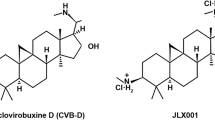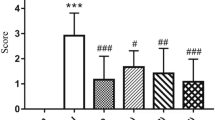Abstract
Recent studies showed that hyperglycemia enhanced brain damage when subjected to transient cerebral ischemic stroke. However, the etiologic link between them has been less known. In the present study, based on an experimental rat’s model of hyperlipidemia combined with cerebral ischemia–reperfusion injury (I/R), we herein showed that hyperlipidemia induced by high-fat diet (HFD) resulted in considerable increase in serum triglycerides, cholesterol and low-density lipoprotein cholesterol, and remarkable decrease in serum high-density lipoprotein cholesterol, which associated with an exacerbation on neurological deficit, cerebral infarct and terminal deoxynucleotidyl transferase-mediated nick end labeling-positive cells in the ischemic hemisphere of cerebral I/R rats treated with HFD diet. The data showed that serum superoxide dismutase activity and glutathione peroxides content were significantly decreased, while malondialdehyde level was obviously increased by hyperlipidemia or cerebral I/R alone, especially by coexistence of hyperlipidemia and cerebral I/R; meantime, hyperlipidemia also enhanced cerebral I/R-induced protein expression of cytochrome P450 2E1 (CYP2E1) and the levels of pro-inflammatory factors tumor necrosis factor-α and IL-6 in the ischemic hemispheres. Furthermore, the combined action of hyperlipidemia and cerebral I/R resulted in a protein increase expression of intercellular adhesion molecule-1 and vascular cell adhesion molecule-1 compared to hyperlipidemia or cerebral I/R alone. Meanwhile, this study also showed that hyperlipidemia significantly enhanced cerebral I/R-induced transfer of cytochrome c from mitochondria to cytosolic and the protein expressions of Apaf-1 and caspase-3, but also decreased cerebral I/R-induced bcl-2 protein expression. The results reveal that hyperlipidemia exacerbates cerebral I/R-induced injury through the synergistic effect on CYP2E1 induction, which further induces reactive oxygen species formation, oxidative stress, inflammation and neuronal apoptosis by coexistence of hyperlipidemia and cerebral I/R.







Similar content being viewed by others
References
Amarenco P, Rother J, Michel P, Davis SM, Donnan GA (2006) Aortic arch atheroma and the risk of stroke. Curr Atheroscler Rep 8:343–346
Ansell BJ (2000) Cholesterol, stroke risk, and stroke prevention. Curr Atheroscler Rep 2:92–96
Badr AE, Yin W, Mychaskiw G, Zhang JH (2001) Dual effect of HBO on cerebral infarction in MCAO rats. Am J Physiol Regul Integr Comp Physiol 280:R766–R770
Becker KJ (2001) Targeting the central nervous system inflammatory response in ischemic stroke. Curr Opin Neurol 14(3):349–353
Cai Q, Wei H (1996) Effect of dietary genistein on antioxidant enzyme activities in SENCAR mice. Nutr Cancer 25:1–7
Cederbaum AI, Wu D, Mari M, Bai J (2001) CYP2E1-dependent toxicity and oxidative stress in HepG2 cells. Free Radic Biol Med 31:1539–1543
Chan PH (2001) Reactive oxygen radicals in signaling and damage in the ischemic brain. J Cereb Blood Flow Metab 21:2–14
Clemens JA (2000) Cerebral ischemia: gene activation, neuronal injury, and the protective role of antioxidants. Free Radic Biol Med 28:1526–1531
Damas P, Canivet JL, de Groote D, Vrindts Y, Albert A, Franchimont P, Lamy M (1997) Sepsis and serum cytokine concentrations. Crit Care Med 25:405–412
De Caterina R, Libby P, Peng HB, Thannickal VJ, Rajavashisth TB, Gimbrone MJ, Shin WS, Liao JK (1995) Nitric oxide decreases cytokine-induced endothelial activation. Nitric oxide selectively reduces endothelial expression of adhesion molecules and proinflammatory cytokines. J Clin Invest 96:60–68
Del ZG, Ginis I, Hallenbeck JM, Iadecola C, Wang X, Feuerstein GZ (2000) Inflammation and stroke: putative role for cytokines, adhesion molecules and iNOS in brain response to ischemia. Brain Pathol 10:95–112
Duckrow RB, Beard DC, Brennan RW (1985) Regional cerebral blood flow decreases during hyperglycemia. Ann Neurol 17:267–272
El Kossi MM, Zakhary MM (2000) Oxidative stress in the context of acute cerebrovascular stroke. Stroke 31:1889–1892
Engstrom G, Lind P, Hedblad B, Stavenow L, Janzon L, Lindgarde F (2002) Effects of cholesterol and inflammation-sensitive plasma proteins on incidence of myocardial infarction and stroke in men. Circulation 105:2632–2637
Fang X-L, Shu G, Yu J-J, Wang L-N, Yang J, Zeng Q-J, Cheng X, Zhang Z-Q, Wang S-B, Gao P, Zhu X-T, Xi QY, Zhang Y-L, Jiang Q-Y (2013) The anorexigenic effect of serotonin is mediated by the generation of NADPH oxidase-dependent ROS. PLoS One 8(1):e53142
Figueroa S, Oset-Gasque MJ, Arce C, Martinez-Honduvilla CJ, González MP (2006) Mitochondrial involvement in nitric oxide-induced cellular death in cortical neurons in culture. J Neurosci Res 83(3):441–449
Gariballa SE, Hutchin TP, Sinclair AJ (2002) Antioxidant capacity after acute ischaemic stroke. QJM 95:685–690
Giugliano D, Ceriello A, Paolisso G (1996) Oxidative stress and diabetic vascular complications. Diabetes Care 19:257–267
Gong W-H, Zheng W-X, Wang J, Chen S-H, Pang B, Hu X-M, Cao X-L (2012) Coexistence of hyperlipidemia and acute cerebral ischemia/reperfusion induces severe liver damage in a rat model. World J Gastroenterol 18(35):4934–4943
Ishikawa M, Stokes KY, Zhang JH, Nanda A, Granger DN (2004) Cerebral microvascular responses to hypercholesterolemia: roles of NADPH oxidase and P-selectin. Circ Res 94:239–244
Jiang X, Wang X (2000) Cytochrome c promotes caspase-9 activation by inducing nucleotide binding to Apaf-1. J Biol Chem 275(40):31199–31203
Jiang YR, Miao Y, Yang L, Xue M, Guo CY, Ma XJ, Yin HJ, Shi DZ, Chen KJ (2012) Effect of chinese herbal drug-containing serum for activating-blood and dispelling-toxin on ox-LDL-induced inflammatory factors' expression in endothelial cells. Chin J Integr Med 18(1):30–33
Kelicen P, Tindberg N (2004) Lipopolysaccharide induces CYP2E1 in astrocytes through MAP kinase kinase-3 and C/EBPbeta and -delta. J Biol Chem 279:15734–15742
Krunkosky TM, Fischer BM, Martin LD, Jones N, Akley NJ, Adler KB (2000) Effects of TNF-alpha on expression of ICAM-1 in human airway epithelial cells in vitro. Signaling pathways controlling surface and gene expression. Am J Respir Cell Mol Biol 22:685–692
Lee TH, Hsu WC, Chen CJ, Chen ST (2002) Etiologic study of young ischemic stroke in Taiwan. Stroke 33:1950–1955
Leppala JM, Vitim J, Fogelholm R, Albanes D, Heinonen OP (1999) Different risk factors for different stroke subtypes: association of blood pressure, cholesterol, and antioxidants. Stroke 30:2535–2540
Lin X, Yu S, Chen Y, Wu J, Zhao J, Zhao Y (2012) Neuroprotective effects of diallyl sulfide against transient focal cerebral ischemia via anti-apoptosis in rats. Neurol Res 34(1):32–37
Liu WY, He W, Li H (2013) Exhaustive training increases uncoupling protein 2 expression and decreases Bcl-2/Bax ratio in rat skeletal muscle. Oxid Med Cell Longev 2013:780719
Lo EH, Dalkara T, Moskowitz MA (2003) Mechanisms, challenges and opportunities in stroke. Nat Rev Neurosci 4:399–415
Longa EZ, Weinstein PR, Carlson S, Cummins R (1989) Reversible middle cerebral artery occlusion without craniectomy in rats. Stroke 20:84–91
Marik PE, Varon J (2001) Sepsis: state of the art. Dis Mon 47:465–532
Matsuo Y, Onodera H, Shiga Y, Shozuhara H, Ninomiya M, Kihara T, Tamatani T, Miyasaka M, Kogure K (1994) Role of cell adhesion molecules in brain injury after transient middle cerebral artery occlusion in the rat. Brain Res 656:344–352
Meyer JS, Rogers RL, Mortel KF, Judd BW (1987) Hyperlipidemia is a risk factor for decreased cerebral perfusion and stroke. Arch Neurol 44:418–422
Nita DA, Nita V, Spulber S, Moldovan M, Popa DP, Zagrean AM, Zagrean L (2001) Oxidative damage following cerebral ischemia depends on reperfusion—a biochemical study in rat. J Cell Mol Med 5:163–170
Oliveira CPMS et al (2006) Liver mitochondrial dysfunction and oxidative stress in the pathogenesis of experimental nonalcoholic fatty liver disease. Braz J Med Biol Res 39:189–194
Papanicolaou DA, Wilder RL, Manolagas SC, Chrousos GP (1998) The pathophysiologic roles of interleukin-6 in human disease. Ann Intern Med 128:127–137
Polidori MC, Mecocci P (2002) Plasma susceptibility to free radical-induced antioxidant consumption and lipid peroxidation is increased in very old subjects with Alzheimer disease. J Alzheimers Dis 4:517–522
Renton KW (2001) Alteration of drug biotransformation and elimination during infection and inflammation. Pharmacol Ther 92:147–163
Sharifkazemi MB, Aslani A, Zamirian M, Moaref AR (2007) Significance of aortic atheroma in elderly patients with ischemic stroke. A hospital-based study and literature review. Clin Neurol Neurosurg 109:311–316
Steinberg HO, Bayazeed B, Hook G, Johnson A, Cronin J, Baron AD (1997) Endothelial dysfunction is associated with cholesterol levels in the high normal range in humans. Circulation 96:3287–3293
Sun Y, Yang D, Kuan C (2012) Mannitol-facilitated perfusion staining with 2, 3, 5-triphenyltetrazolium chloride (TTC) for detection of experimental cerebral infarction and biochemical analysis. J Neurosci Methods 203:122–129
Takechi R, Galloway S, Pallebage-Gamarallage MM, Lam V, Dhaliwal SS, Mamo JC (2013) Probucol prevents blood–brain barrier dysfunction in wild-type mice induced by saturated fat or cholesterol feeding. Clin Exp Pharmacol Physiol 40:45–52
Tiku ML, Liesch JB, Robertson FM (1990) Production of hydrogen peroxide by rabbit articular chondrocytes. Enhancement by cytokines. J Immunol 145:690–696
Tziomalos K, Athyros VG, Karagiannis A, Mikhailidis DP (2009) Dyslipidemia as a risk factor for ischemic stroke. Curr Top Med Chem 9:1291–1297
Wang H, Pan Y, Xue B, Wang X, Zhao F et al (2011) The antioxidative effect of electro-acupuncture in a mouse model of Parkinson's disease. PLoS One 6:e19790
Wigg AJ et al (2001) The role of small intestinal bacterial overgrowth, intestinal permeability, endotoxaemia, and tumour necrosis factor alpha in the pathogenesis of non-alcoholic steatohepatitis. Gut 48:206–211
Wills ED (1966) Mechanisms of lipid peroxide formation in animal tissues. Biochem J 99:667–676
Yan MX, Li YQ, Meng M, Ren HB, Kou Y (2006) Long-term high-fat diet induces pancreatic injuries via pancreatic microcirculatory disturbances and oxidative stress in rats with hyperlipidemia. Biochem Biophys Res Commun 347(1):192–199
Yang J, Liu X, Bhalla K, Kim CN, Ibrado AM, Cai J, Peng TI, Jones DP, Wang X (1997) Prevention of apoptosis by Bcl-2: release of cytochrome c from mitochondria blocked. Science 275:1129–1132
Yoh K, Hirayama A, Ishizaki K, Yamada A, Takeuchi M, Yamagishi S, Morito N, Nakano T, Ojima M, Shimohata H, Itoh K, Takahashi S, Yamamoto M (2008) Hyperglycemia induces oxidative and nitrosative stress and increases renal functional impairment in Nrf2-deficient mice. Genes Cells 13:1159–1170
Zechariah A, ElAli A, Hagemann N, Jin F, Doeppner TR, Helfrich I, Mies G, Hermann DM (2013) Hyperlipidemia attenuates vascular endothelial growth factor-induced angiogenesis, impairs cerebral blood flow, and disturbs stroke recovery via decreased pericyte coverage of brain endothelial cells. Arterioscler Thromb Vasc Biol 33(7):1561–1567
Acknowledgments
This work was supported by the National Natural Science Foundation of China (No. 31171327).
Author information
Authors and Affiliations
Corresponding author
Additional information
Xiao-Lu Cao and Jing Du are the co-first authors.
Rights and permissions
About this article
Cite this article
Cao, XL., Du, J., Zhang, Y. et al. Hyperlipidemia exacerbates cerebral injury through oxidative stress, inflammation and neuronal apoptosis in MCAO/reperfusion rats. Exp Brain Res 233, 2753–2765 (2015). https://doi.org/10.1007/s00221-015-4269-x
Received:
Accepted:
Published:
Issue Date:
DOI: https://doi.org/10.1007/s00221-015-4269-x




